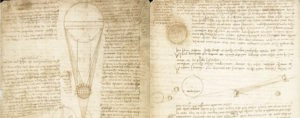‘Notebook of a Genius’: Da Vinci Exhibition at the Uffizi
 Until Jan. 20: WATER AS A MICROSCOPE OF NATURE: LEONARDO DA VINCI’S LEICESTER CODEX. Uffizi, Aula Magliabechiana. Open Tuesday through Sunday 8:15 am—6:50 pm (ticket office closes 6:20 pm). Admission to exhibition is included in ticket purchase to the Uffizi.
Until Jan. 20: WATER AS A MICROSCOPE OF NATURE: LEONARDO DA VINCI’S LEICESTER CODEX. Uffizi, Aula Magliabechiana. Open Tuesday through Sunday 8:15 am—6:50 pm (ticket office closes 6:20 pm). Admission to exhibition is included in ticket purchase to the Uffizi.
The Leicester Codex of Leonardo da Vinci returns to Florence on the 500th anniversary of the death of the great scientist, artist and thinker. This collection of scientific writings and drawings, purchased by American Bill Gates in 1994 for 30.8 million dollars, allows visitors to get inside Da Vinci’s head and explore his creative process.
The central theme of the Codex, water, provides an insight into the inquiring mind of the archetype of the Renaissance man. In 72 pages, the world of water—currents, waves, tides, whirlpools, bridges, canals, locks, dams and sketches of projects for land reclamation as well as the use of water for military purposes portrays a mind eager to understand its nature, exploit its energy and control its potentially destructive properties.
The annotations of the Leicester Code were made from 1504-1508, the height of the Renaissance, an era in which Benvenuto Cellini called Florence the “school of the world.” Da Vinci, now in his 50s, was working on his famous painting Battle of Anghiari, presently thought by some art historians to be hidden under another painting in the Palazzo Vecchio’s Salone del Cinquecento (Hall of the Five Hundred). But the artist’s continued fascination with water, led him to return to his notebook, sketching out elaborate plans to make the Arno River navigable from Florence to the sea.
In addition to the water theme, visitors to the exhibit are offered a vision of the vastness of the horizons explored by Da Vinci’s mind. The journal contains observations on geology, an explanation of why fossils can be found on mountains and why the moon is paler than the sun. Da Vinci concluded the nature of the moon’s luminosity was due to its covering of water which reflected light from the sun, describing the phenomenon of “planetshine” which German astronomer Johannes Kepler managed to prove 100 years later
The Uffizi exhibition allows people the opportunity to delve into the mind of this great genius, a child born out of wedlock who never received a formal education but spoke with pride about being self-taught in later life. Even more uncanny, the notes in his 16th century brainstorming journal are written “mirror style” from right to left, punctuated by his sketches. Scholars have speculated Leonardo wrote in this manner to hide his scientific ideas from the powerful Roman Catholic Church, whose teachings sometimes disagreed with what he observed. Or, perhaps simply because he was left handed and didn’t want his sleeve to smudge the ink.
The pages, yellowed by age, originally bound together, have now been mounted between glass panes and displayed separately. With the use of an advanced digital tool called the Codescope, which produces a reversal of his writing, visitors to the exhibit can leaf through individual pages of the manuscript and read the transcriptions in English and Italian. At the end of the show, an eight-minute video in Italian and English reveals Leonardo’s theories on the role of water in the evolution of planet earth.
Visitors might want to combine a close up view of this 16th century journal with a look at Room 15, two floors above in the Uffizi. This recently added gallery contains some of Leonardo da Vinci’s masterpieces, including the Adoration of the Magi and the Annunciation.
For further information and ticket sales and reservations online, visit the Uffizi website: www.uffizi.it (rita kungel)
